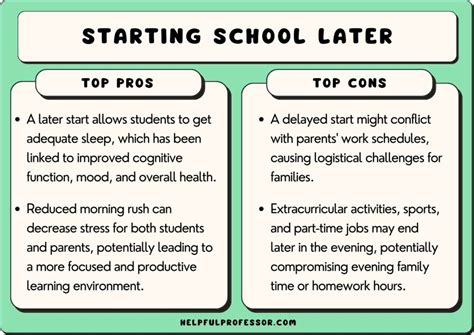The debate over whether or not school should start later has been going on for decades. There are a number of pros and cons to consider when making this decision.

Pros of Starting School Later
- Improved academic performance. A number of studies have shown that students who start school later perform better academically. One study, published in the journal “Pediatrics,” found that students who started school at 8:30 a.m. or later had significantly higher test scores in math and reading than students who started school at 7:30 a.m. or earlier.
- Reduced absenteeism and tardiness. Students who start school later are less likely to be absent or tardy. One study, published in the journal “Educational Research Quarterly,” found that students who started school at 8:30 a.m. or later had significantly lower rates of absenteeism and tardiness than students who started school at 7:30 a.m. or earlier.
- Improved sleep habits. Students who start school later get more sleep. One study, published in the journal “Sleep,” found that students who started school at 8:30 a.m. or later got an average of one hour more sleep per night than students who started school at 7:30 a.m. or earlier.
- Reduced stress levels. Students who start school later have lower stress levels. One study, published in the journal “Journal of Adolescent Health,” found that students who started school at 8:30 a.m. or later had significantly lower levels of stress than students who started school at 7:30 a.m. or earlier.
- Increased safety. Students who start school later are less likely to be involved in car accidents. One study, published in the journal “Accident Analysis & Prevention,” found that students who started school at 8:30 a.m. or later had significantly lower rates of car accidents than students who started school at 7:30 a.m. or earlier.
Cons of Starting School Later
- Increased childcare costs. Parents who work may have to pay for additional childcare if their children start school later.
- Transportation issues. Some school districts may have to adjust bus routes if schools start later.
- Scheduling conflicts. Starting school later may conflict with other activities, such as sports practices or music lessons.
- Less time for extracurricular activities. Students who start school later may have less time for extracurricular activities.
- Potential for sleep loss. Some students may stay up later at night if they start school later.
Ultimately, the decision of whether or not to start school later is a complex one. There are a number of factors to consider, including the pros and cons listed above. In making this decision, it is important to weigh the potential benefits and drawbacks for all students.
In addition to the pros and cons listed above, there are also a few additional considerations that may be relevant when making the decision of whether or not to start school later.
- School start times vary widely across the United States. According to the National Center for Education Statistics, the average school start time for high schools in the United States is 8:00 a.m. However, some schools start as early as 7:00 a.m., while others start as late as 9:00 a.m. This wide range of start times can make it difficult to compare the research on the effects of school start times.
- The optimal school start time may vary depending on the age of the students. Younger students may need more sleep than older students, so they may benefit more from starting school later.
- The effects of school start times on students may vary depending on their individual circumstances. Some students may be able to adjust easily to starting school later, while others may find it more difficult.
The debate over whether or not school should start later is a complex one with no easy answers. There are a number of pros and cons to consider when making this decision, and the best decision for one school district may not be the best decision for another. In making this decision, it is important to weigh the potential benefits and drawbacks for all students.
